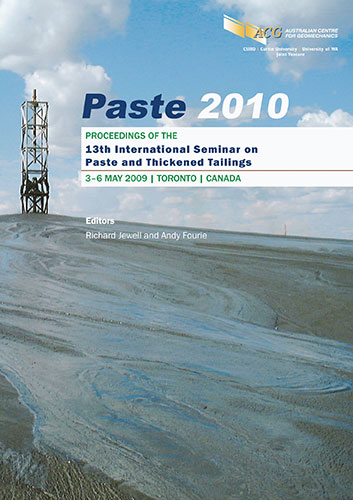A novel waste water cleanup, fines sequestration and consolidation technology for oil sands applications

|
Authors: Soane, D; Ware, W; Mahoney, R; Kincaid, P Paper is not available for download Contact Us |
DOI https://doi.org/10.36487/ACG_rep/1063_40_Soane
Cite As:
Soane, D, Ware, W, Mahoney, R & Kincaid, P 2010, 'A novel waste water cleanup, fines sequestration and consolidation technology for oil sands applications', in R Jewell & AB Fourie (eds), Paste 2010: Proceedings of the Thirteenth International Seminar on Paste and Thickened Tailings, Australian Centre for Geomechanics, Perth, pp. 459-466, https://doi.org/10.36487/ACG_rep/1063_40_Soane
Abstract:
Soane Energy has developed a wastewater treatment technology capable of rapidly sequestering suspended fines and other pollutants from tailings produced during oil sand operations, thus arresting a growing environmental problem at its source. The technology can also be adapted to clarification of existing tailings ponds, mitigating a major environmental liability. This platform technology, termed the ATA System, comprises three basic components: an Activator polymer, a Tether polymer and an Anchor particle. First, a small dose of the Activator polymer is added to the fine or mature tailings, causing the suspended clay fines to aggregate. Separately, the Anchor particles are coated with a Tether polymer. Sand derived from coarse tails provides a convenient source of the Anchor particle, due to its abundance at oil sand sites. The Tether-bearing Anchor particles exhibit a strong affinity to the clay fines in the Activated tailings. When the two treated streams are combined, the Tether-bearing Anchor particles quickly bind to the aggregated clay fines in the Activated tailings, forming robust complexes that can be easily separated from the waste stream. Two output streams emerge from the ATA process: a clean water stream that can be reused in the oil sands extraction process, and a dewatered solid that possesses sufficient mechanical integrity for landfill, construction and/or reclamation applications. Recycling of clean water produced by the ATA process can significantly decrease the need for fresh water intake. Moreover, since this process removes fines from water almost instantaneously, the recycled water retains a significant amount of the sensible heat, reducing the energy requirement of oil sand extraction and concomitant green house gas emission.
References:
Azam, S. and Scott, J.D. (2005) Revisiting the ternary diagram for tailings characterization and management,
Geotechnical News, December 2005, pp. 43–46.
Beier, N. and Sego, D. (2008) Oil Sands Tailings Research Facility, Geotechnical News, June 2008.
Griffiths, M. and Woynillowicz, D. (2003) Oil and Troubled Waters: Reducing the impact of the oil and gas industry on
Alberta’s water resources, Pembina Institute, April 2003.
MacKinnon, M.D., Matthews, J.G., Shaw, W.H. and Cuddy, R.G. (2001) Water quality issues associated with
implementation of composite tailings (CT) technology for managing oil sands tailings, International Journal of
Surface Mining, Reclamation, and Environment, Vol. 15, No. 4, pp. 235–256.
Paradis, T. (2008) Non segregating tailings at the Horizon oil sands project, Presentation at 2008 International Oil
Sands Tailings Conference, December 8, 2008, Edmonton, Alberta.
Sobkowicz, J.C. and Morgenstern N.R. (2009) A geotechnical perspective on oil sands tailings, Tailings and Mine
Waste, pp. xvii–xxxix.
© Copyright 2025, Australian Centre for Geomechanics (ACG), The University of Western Australia. All rights reserved.
View copyright/legal information
Please direct any queries or error reports to repository-acg@uwa.edu.au
View copyright/legal information
Please direct any queries or error reports to repository-acg@uwa.edu.au